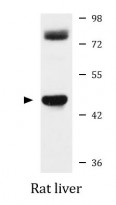ARG59093
anti-SFTPB / Prosurfactant Protein B antibody
anti-SFTPB / Prosurfactant Protein B antibody for Western blot and Human,Mouse,Rat
Overview
| Product Description | Rabbit Polyclonal antibody recognizes SFTPB / Prosurfactant Protein B |
|---|---|
| Tested Reactivity | Hu, Ms, Rat |
| Tested Application | WB |
| Host | Rabbit |
| Clonality | Polyclonal |
| Isotype | IgG |
| Target Name | SFTPB / Prosurfactant Protein B |
| Antigen Species | Human |
| Immunogen | Recombinant fusion protein corresponding to aa. 94-393 of Human SFTPB / Prosurfactant Protein B (NP_000533.3). |
| Conjugation | Un-conjugated |
| Alternate Names | SP-B; 18 kDa pulmonary-surfactant protein; SFTP3; Phe; Pulmonary surfactant-associated proteolipid SPL; PSP-B; Pulmonary surfactant-associated protein B; 6 kDa protein; SMDP1; SFTB3 |
Application Instructions
| Predict Reactivity Note | Human | ||||
|---|---|---|---|---|---|
| Application Suggestion |
|
||||
| Application Note | * The dilutions indicate recommended starting dilutions and the optimal dilutions or concentrations should be determined by the scientist. | ||||
| Positive Control | Rat liver | ||||
| Observed Size | 50kDa |
Properties
| Form | Liquid |
|---|---|
| Purification | Affinity purified. |
| Buffer | PBS (pH 7.3), 0.02% Sodium azide and 50% Glycerol. |
| Preservative | 0.02% Sodium azide |
| Stabilizer | 50% Glycerol |
| Storage Instruction | For continuous use, store undiluted antibody at 2-8°C for up to a week. For long-term storage, aliquot and store at -20°C. Storage in frost free freezers is not recommended. Avoid repeated freeze/thaw cycles. Suggest spin the vial prior to opening. The antibody solution should be gently mixed before use. |
| Note | For laboratory research only, not for drug, diagnostic or other use. |
Bioinformation
| Database Links | |
|---|---|
| Gene Symbol | SFTPB |
| Gene Full Name | surfactant protein B |
| Background | This gene encodes the pulmonary-associated surfactant protein B (SPB), an amphipathic surfactant protein essential for lung function and homeostasis after birth. Pulmonary surfactant is a surface-active lipoprotein complex composed of 90% lipids and 10% proteins which include plasma proteins and apolipoproteins SPA, SPB, SPC and SPD. The surfactant is secreted by the alveolar cells of the lung and maintains the stability of pulmonary tissue by reducing the surface tension of fluids that coat the lung. The SPB enhances the rate of spreading and increases the stability of surfactant monolayers in vitro. Multiple mutations in this gene have been identified, which cause pulmonary surfactant metabolism dysfunction type 1, also called pulmonary alveolar proteinosis due to surfactant protein B deficiency, and are associated with fatal respiratory distress in the neonatal period. Alternatively spliced transcript variants encoding the same protein have been identified.[provided by RefSeq, Feb 2010] |
| Function | Pulmonary surfactant-associated proteins promote alveolar stability by lowering the surface tension at the air-liquid interface in the peripheral air spaces. SP-B increases the collapse pressure of palmitic acid to nearly 70 millinewtons per meter. [UniProt] |
| Cellular Localization | Secreted, extracellular space, surface film. [UniProt] |
| Calculated MW | 42 kDa |
Images (1) Click the Picture to Zoom In






